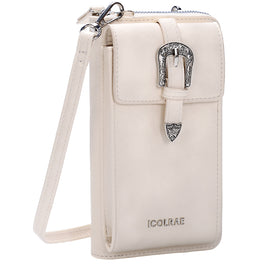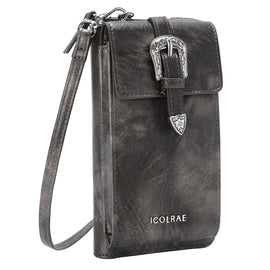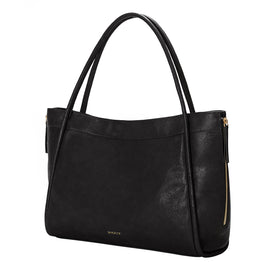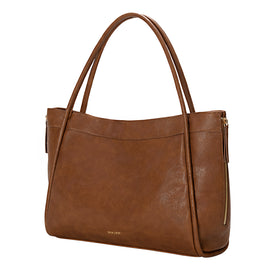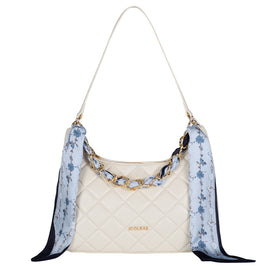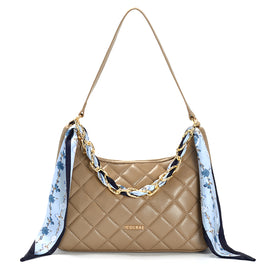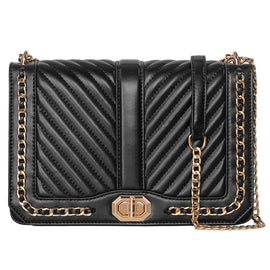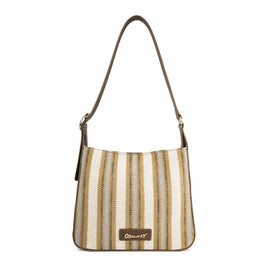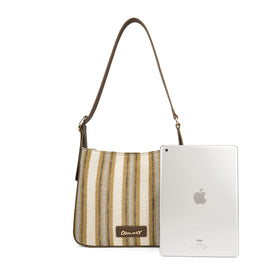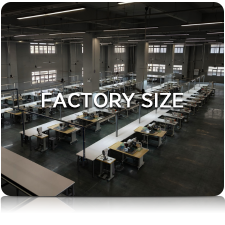What is the manufacturing process of leather tassel bags
Leather tassel bags are a timeless style that blends movement, texture, and a handcrafted feel—tassels can make a simple silhouette feel playful, bohemian, or luxe depending on material and finishing. For brands and designers, understanding how tassel bags are made gives better control over quality, cost, and the final look. Below is a practical, step-by-step guide to the typical manufacturing process, plus expert tips from HerminFashion on design choices, testing, and scaling from prototype to production.
1. What is a leather tassel bag? (Quick overview)
A leather tassel bag is any handbag that incorporates tassel elements as a visible design feature—these may be attached to zippers, straps, flaps, or hang as decorative fringes from the body. Tassels can be cut from the same hide as the bag (integrated fringe), made as separate finished ornaments, or braided/knotted for a different aesthetic.
Common tassel styles:
-
Cut-fringe tassel: one piece of leather with many parallel cuts.
-
Strip tassel: many thin strips gathered and capped.
-
Braided tassel: strips braided or twisted for texture.
-
Multi-layer tassel: layered lengths for volume and movement.
2. Materials & components (what you need)
Typical materials and components used for leather tassel bags:
Leathers
-
Full-grain or top-grain cowhide (durable, premium patina)
-
Lambskin (soft, luxe but more delicate)
-
Suede / nubuck (matte, textured look)
-
PU or high-quality coated leather (vegan, consistent color)
Other materials
-
Linings (polyester, cotton, or recycled fabrics)
-
Interfacings/foam for body structure
-
Hardware (rings, caps, rivets, clips, toggles)
-
Thread (bonded nylon or polyester for strength)
-
Adhesives and edge paint
Tools & machines
-
Pattern drafting tools / CAD software
-
Die-cutting or automatic cutting machines (clicker press, CNC)
-
Skiving machine (thin edges)
-
Industrial sewing machines (walking foot, post-bed)
-
Rivet press, snap setter, eyelet machine
-
Edge burnishers, edge painters, polishing stations
HerminFashion can source these materials and recommend certified eco options (recycled PU, vegetable-tanned leathers, low-VOC coatings) based on brand priorities.
3. Step-by-step manufacturing process
Step A — Design & tech pack
-
Finalize silhouette, tassel style, dimensions, hardware, stitch lines, and artwork.
-
Create a detailed tech pack: measurements, materials with GSM/thickness, color codes (Pantone or sample swatches), construction notes, and placement drawings for tassels.
-
Decide whether tassels are fixed or detachable—detachable tassels add user flexibility but require additional hardware.
Step B — Pattern making & prototyping
-
Convert sketches into precise paper or digital patterns.
-
Produce a prototype (sample) to test proportions—tassel length is critical. Typical tassel length varies with bag size; for small bags 4–6 in (10–15 cm), for larger totes 6–10 in (15–25 cm) are common starting points.
-
Iterate: designers often create 2–3 sample rounds to adjust tassel density, cap style, and placement.
Step C — Tooling & cutting
-
For leather, use die-cutting or CNC cutting to achieve consistent fringe widths and lengths. Nesting patterns efficiently reduces waste.
-
For tassel strips, some factories use a fringe-cutting die; others cut a sheet into strips then trim to length.
-
Skive edges where needed (thin the leather for folding or seam allowance).
Step D — Tassel construction
Two common workflows:
Integrated fringe (one-piece)
-
Cut a rectangular panel.
-
Make parallel cuts to create the fringe.
-
Fold the top and stitch or glue to form a loop or attach directly to the bag panel.
Separate tassel assembly
-
Cut many narrow strips.
-
Gather and glue/ stitch at the top.
-
Cap the top with a metal cap or stitched leather band, then fix a ring/clip.
-
Optionally braid or layer strips for texture.
Quality points: ensure even strip width, clean cut ends, secure caps (crimped or riveted) and tidy glue lines.
Step E — Main body construction & stitching
-
Assemble main panels, add interfacings, sew pockets and linings.
-
Install hardware (D-rings, studs, zippers) and attach straps.
-
Use bar-tack reinforcements at stress points (strap ends, pocket openings).
Step F — Attaching tassels & finishing
-
Attach tassels by stitching through a hidden tab, using a rivet, or linking via a D-ring/clasp for detachable styles.
-
Edge finish: paint, burnish, or lacquer edges for a polished look.
-
Clean, condition, and inspect—remove excess glue and check color uniformity.
Step G — Quality control & testing
QC checklist typically includes:
-
Stitch density and seam strength tests
-
Tassel pull/attachment test (apply force to ensure secure connection)
-
Hardware plating inspection (no flaking)
-
Color and shade consistency across batches (Pantone matching)
-
Functional tests (zipper cycles, strap adjustment)
-
Finish durability (rub/crock tests)
Step H — Packaging
-
Fold and stuff to shape, insert silica if needed, place in dust bag, attach hangtags, and pack into master cartons. Include care instructions (how to care for leather tassels).
4. Variations & design considerations (practical tips)
-
Proportion matters: tassels that are too long can tangle or overpower a small bag; too short can look fussy. Always evaluate tassel length vs. bag height and strap length.
-
Weight management: leather tassels add weight. For lightweight designs, consider thinner leather, suede, or faux options.
-
Detachable vs fixed: detachable tassels give consumers customization options and simplify shipping (reduce snagging).
-
Color matching: tassels can match or contrast; HerminFashion uses calibrated color systems (lab dips / physical swatches) to ensure batch consistency.
-
Maintenance: advise consumers on leather conditioning; for suede tassels include brush care guidance.
5. Quality, testing & lead times (what brands should expect)
-
Sample stage: 1–2 weeks for pattern/sample depending on complexity. (Highly custom caps or hardware can add time.)
-
Pre-production & tooling: 1–3 weeks for die and mold creation.
-
Mass production: typical lead time 30–60 days depending on order size, complexity, and material availability.
-
Testing: pull tests, abrasion/rub tests, and hardware fatigue testing are recommended before bulk runs.
HerminFashion recommends 2–3 prototype iterations and a small pilot run to validate tassel attachment and wear behavior.
6. Sustainability & material options
-
Vegetable-tanned leather develops a patina but uses traditional plant tannins; it’s a good eco option when sourced responsibly.
-
Recycled/sustainably produced PU leather and microfiber leathers offer consistent color and lower environmental impact in some specs.
-
Low-VOC adhesives and water-based edge paints reduce emissions during production.
HerminFashion can help brands source certified materials and advise on tradeoffs between look, cost, and environmental footprint.
7. Advice for startups & designers (practical checklist)
-
Decide tassel function first (purely decorative vs interactive).
-
Test tassel attachment under realistic conditions (carry weight, swing tests).
-
Consider detachable tassels for gifting or multi-style SKUs.
-
Keep tooling costs in mind—complex metal caps or custom hardware increase per-unit cost.
-
Order material swatches and a small pilot run before committing to full production.
8. How HerminFashion supports tassel-bag projects
HerminFashion offers end-to-end services for brands at every stage:
-
Design consultation: advising on proportion, tassel type, and placement for brand alignment.
-
Material sourcing: recommending leathers, linings, and sustainable alternatives.
-
Rapid prototyping: sample development, lab dips, and physical mockups.
-
Precision tooling & consistent production: die cutting, automated nesting, and QC systems to ensure repeatability.
-
Compliance & finishing: advice on care labeling, packaging, and test reports for retail requirements.
We work with startups and established brands to translate creative sketches into reliable, production-ready products—helping balance aesthetic goals with manufacturability and cost.
Conclusion
Leather tassel bags combine craft and detail—well-executed tassels elevate a silhouette but require careful planning: the right material, precise cutting, secure attachment, and rigorous QC. Whether you want a soft suede fringe or a polished leather tassel capped in metal, understanding the production steps helps you design smarter and launch more successful products.
If you’re developing a tassel bag collection, HerminFashion can partner from prototype to production, advising on materials, functional testing, and scaled manufacturing to bring your vision to market with confidence.

